Editor’s note: The following is extracted from Shots Fired in Anger: A Rifleman’s-Eye View of the Activities on the Island of Guadalcanal, by Lt. Col. John B. George (published 1947).
The Nambu Light Machine Guns
In the tangled jungle surrounding Hill 27 and Hill 31, the Japanese had made good use of their engineer tools. They had dug and hacked extensively all along the forward slope of Hill 31, probably wearing out the blades of many brush knives and dulling many axe blades on the soft but resistant wood of tropical broad- leaf trees and tangled vines which were sometimes two feet thick.
They had burrowed under and around the roots of forest giants in a manner that would have done credit to a New England wood-chuck. Sharp-edged entrenching shovels, far better than those used by the Americans swarming on the beaches five miles away, had been plied day after day, night after night, providing for the comfort and security of an old and traditional type reception committee, which would wait attentively for the arrival of the first wave of green clad, light skinned, blond haired visitors.
These reception committee shelters were sighted with care so that there would be little or no chance of any visitor approaching unseen or unheard. The visitors would have to make their way through particularly inhospitable stretches of foliage before they approached their “hosts,” clawing often at plant stems and turning now and then to remove the sticky, holding whip of a wait-a- minute vine from the cloth of a jacket or the flesh of a cheek or hand. The last few steps toward the waiting hosts would be in clearer, more open, spots in the jungle — not completely clear, but open as though these spots of ground had perhaps offered less appeal to roots of jungle weeds than had the surrounding area. And the first guests these hosts would receive in time-honored style would, at the moment of reception, be breathing thanks for a few feet of clear space in front of them.
But while the hosts were taking every step to prevent the guests from arriving unseen or unannounced, it was none the less their desire that the reception was to be in the nature of a surprise party. Along with the committee housing project there was also heavy effort under way to prevent the excavations from becoming an eyesore and smearing the pretty green landscape with unsightly mounds of yellow clay, framing the entrances to the committee chambers in a highly unartistic way — all out of keeping with the natural tropical garden atmosphere.
So, while some of the hosts dug with shovels and picks, others were busy with baskets woven from vines in which they carried away load after load of yellow dirt to a hidden place to the rear of the line of diggings. There the dirt was scattered around the roots of heavy brush where it would not change the garden picture of the “back yards,” or else it was thrown into a little stream where it was washed away, yellowing the clean spring water. So thorough was this operation that scarcely one clod of yellow dirt was left to mar the perfect scene of green and dark shadow which surrounded the picturesque area.
After the rough line of shelters was finished, the sturdy, well muscled little builders got to work industriously upon a series of connecting tunnels, just large enough for the small and wiry bodies of the hosts to move through with comfort. These were artistically done, with the little bites of the shovels showing on their inside walls like adze marks on hewn logs. Roots were sharply and cleanly cut, cross-sections showing and oozing sap, mostly milk white and latex-bearing. And after the tunnels had been dug — a regular network of them to connect all of the individual larger shelters with each other — another project was begun. The chambers were enlarged and made more comfortable, and their roofs were built up solidly against the elements, with layer after layer of logs and pounded earth, which was now needed in such quantity at the building site that there was no need to carry it away. But the unsightly yellow of it was still not allowed to show. It was carefully covered over with sod, carefully matched to the local landscape. The hosts were still much concerned about the outside appearance of their dwellings.
Each of the chambers had a small window, left open permanently, facing to the front. This was to serve the combined purposes of ventilator and living room window, permitting the host to breathe comfortably, see his front yard, and greet his guests. And the chambers were as near storm-proof as structures could be. Any one of them would have made an absolutely safe hurricane shelter. The areas in front of the windows were sodded over care fully so that no dry leaves or other substance could be blown up into the chamber by a sudden gust of wind, and then the square outline of the window was artistically broken up by the bending and sometimes actual transplanting of pretty leaved plants, making the whole dome of the chamber-structure blend perfectly into the shadowy undergrowth.
Remaining improvements were in the way of gouging little shelves along the chamber walls. These would contain bits of bric-a-brac to be presented to the visitors!
When they began to build these shelves the hosts were able to sigh with relief and know that they had finished their greater preparations before the visitors arrived. It is always embarrassing for visitors to arrive before one is ready to receive! The small finishing touches were still being completed when the visitors finally got there.
It happened on a bright morning in December, and there was really no need to look carefully for the visitors, for they proclaimed their coming five hours in advance with a vast and imposing display of fireworks. There were repeated blinding flashes and deafening sounds all around the hosts’ chambers through the last darkness and early dawn. The hosts waited and gave no reply because they still wanted it to be a surprise party.
Soon after dawn the fireworks let up and there was silence. Each host stood ready in place for the greeting ceremony. Naturally there were various grades of hosts. There were little hosts who waited in smaller chambers with small gifts to give the visitors, and there were large hosts who waited in larger chambers, prepared to give gifts in much larger quantities. These larger hosts were the most important, and the whole scheme of the reception had been planned with great consideration for the part they were to play in the ceremony.
The smaller hosts were situated in smaller chambers with smaller front yards, and in locations where they would be less likely to receive large numbers of visitors. They were not so well supplied with gifts, and they lacked the means to distribute the presents as fast as their more important colleagues. Their chief concern was not so much the distribution of gifts as it was the saving of the larger hosts from embarrassment if several visitors were to arrive at the rear entrance. In such cases, they had been told to greet the visitors themselves so that the larger hosts could devote their attention to visitors approaching the front doors.
Despite all of these beautiful preparations, the reception on Hill 31 was not too much of a surprise. A large group of visitors were proceeding through the undergrowth. When their leader saw the front yards of the reception committee shelters, he halted the main body of guests and went forward to look. He passed through the front yard of one of the lesser greeters, who either did not see him or else left him to be greeted by one of the larger hosts. After all, the whole ceremony had been planned around the larger hosts since they were the ones who were really prepared to greet guests.
A dark-haired little man, whose brown skin had gone white from continued life underground and in jungle shadows, finally saw the first visitor through his small window. The visitor had walked to the edge of the host’s little front yard and hesitated for a moment, then he had walked into the center and looked back toward the rest of the guests, ready to call them forward, or perhaps ready to tell them to wait — it will never be known which. The host became over-anxious, perhaps fearing that the other guests would be lost to his hospitality, perhaps not knowing of their presence. Anyway, he put his whole heart and soul into the matter of greeting this one guest before him, throwing a full twenty gifts his way.
A young officer, nameless here, was the greeted one. Trained in the States, gifted with little knowledge of the wilds — certainly none of junglecraft — he had nonetheless sensed danger and saved the lives of his command. His own fate was of a quick sort, by no means the type of death a soldier prays for, for most of us would prefer to die with enemy blood on our hands, but there was no suffering for him — not more than a few seconds.
A Japanese automatic weapon, one of several models which were to earn our unqualified respect through the Islands and in Burma, had been sighted at the calves of his legs at a range of less than thirty feet.
The first few rounds of the clip, ripping out at the cyclic rate of 500 per minute, had made jelly out of his legs and swept them from under him, causing his body to fall into the stream of fire still sizzling past. The last few rounds of the clip were clustered in one area, raking his heart and lung cavity from upper left shoulder to lower right ribs.
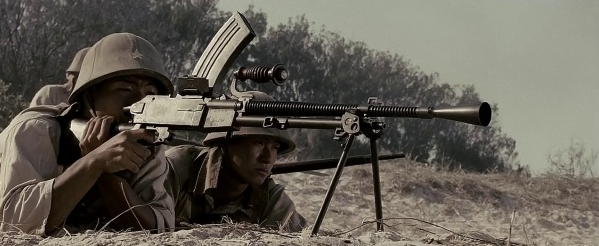
The gun that killed him was a Nambu Light, always the base weapon of the Japanese fire plan in defense, the deadly automatic gun which some of us believe killed more men than all other Japanese weapons combined — an efficient, well-designed, and practical weapon. Had it not been for the gunner’s impatience, or had this platoon leader been less alert, it might have killed a dozen men instead, as was the case in many later instances.
This incident was the first experience of that particular American unit with the Nambu Light, but it was by no means the first contact known with it on the Island. The Marines had developed a healthy respect for it in the very first battles they had had on Tulagi and Guadalcanal. The first Army troops who saw action on the Island had seen it employed first in the attack, fired from the assault position with great carelessness, spraying bullets wildly. But later they had encountered this weapon as we encountered it — in the defense — and it had proved to be as dangerous and consistently fatal as any of them had dreamed. And its most dangerous role was in this sort of defense — holding ground in the jungle.
The Japanese seemed to lack imagination when they were moving into us. They attacked with matchless savagery and courage, but the effort always seemed to lack the important element of common sense — which has a more important place in Infantry tactics and weapons employment than any place else I know. The fire of Japanese attack forces was usually frontal, giving away the direction and positions of the attackers. At the same time, it was greatly limited in accuracy because it was “assault fire” — fire delivered by men who were moving forward, firing a shot or burst now and then from the standing or kneeling position.
Perhaps it would have been excusable for the Japanese to follow the Banzai attack procedure with the riflemen only, allowing the automatic weapons to provide a covering fire. This fire could be from a position selected as a “base of fire” — off to the side, or on higher ground. But the Japs didn’t even do that much. They usually went whole hog for the advancing elements. The result was that no one was shooting during the very moments which logically required the greatest volume of fire to be delivered. With the entire attacking force in on a big bayonet rush, there was usually a lull — if not a complete break — in the delivery of accurate fire.
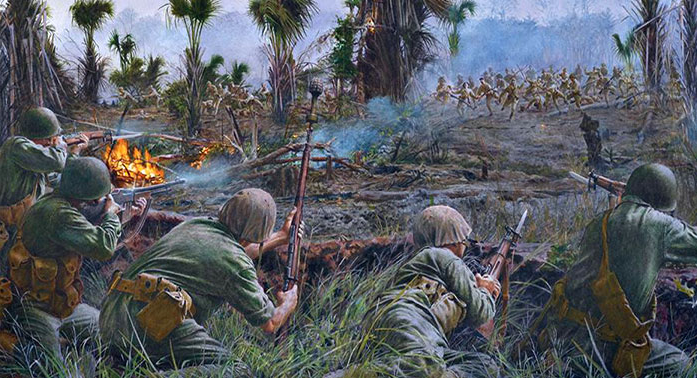
The adverse effect of such poor use of firepower is too obvious to even describe. The members of such an attacking force would move into a deadly hail of fire delivered by men who were not forced to keep their heads down. They could crane their necks about and carefully aim at oncoming cold turkey targets — Japanese soldiers at point blank range. In such cases the slaughter was unbelievable, even if the attack was delivered during bad conditions of visibility or at night. And I have personally been involved in enough of these affairs to know that they occurred frequently. If the defenders had enough ammunition and kept their heads, these attacks always ended by being terrible fiascos for the Japanese. And they received a name, often repeated by a million doughboys and Marines, which became familiar to every one throughout the Island — the “Banzai” charge.
The Jap high command itself, at least in the beginning of the war, continued to think that they really had something in that Banzai charge, for they whooped it up in all of their books on tactics. They maintained that the attack was the only honorable form of fighting, and that a good, aggressive commander need never rely upon defensive tactics; and they greatly neglected defense in their training publications, at least through the early Pacific war. However, they conceded in some of their later publications that Japanese soldiers were not especially skilled in defensive warfare — that perhaps there were European armies that knew more about it and were better fitted for it. Japanese Infantry was strongest, they said, in offensive fighting. The attack — especially the night attack — was, by their own appraisal, a specialty of Japanese Infantry.
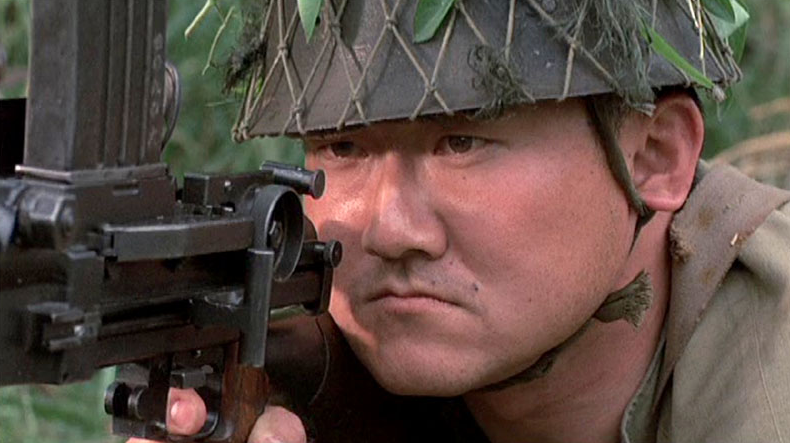
Actually, this conception was one hundred percent wrong. Japanese Infantry was clownish and stupid beyond belief in the attack — the phase of war which involves fire, movement, and which demands the taking of ground from a defending force. But in the defense, entrenched or in the cover of the jungle, the Japanese were absolute past-masters, far more capable than they imagined themselves to be. Their rugged physical condition and peasant background made them skillful and untiring at digging, and their unlimited tenacity and guts permitted them to hold bravely in the face of superior numbers.
Some of the Infantry training manuals of all Armies carry a hackneyed paragraph or two which says outrightly or infers: “…in the defense, unless ordered otherwise, our forces will always hold and fight to the last man….” The Italians made a joke of that sentence; in many cases the Germans did too; we certainly did. Only scattered American units can claim that they fought to the last man, except in the later days of the Pacific War, after we had learned that surrender to the Japanese was useless.
But the Japanese I have been up against, with negligible individual exceptions, carried out that pledge to the letter. How often did we hear the familiar communique, “Blank Island was taken today, the Japanese garrison of fifteen thousand having been destroyed. Eighty prisoners were taken….”
Eighty out of fifteen thousand! Figure it out….
The Japanese Infantrymen and fighter and kamikaze pilots were, as a class, the bravest men who fought in this last war. Rationalizing individuals have called it fanaticism and ignorance instead of bravery, and have sold a lot of people upon the story that Japanese Infantrymen would have surrendered freely if they had known they would not be tortured after capture. For my part, I don’t care what is said about the Japanese. They have a lot of moral and spiritual defects, the greatest of which would seem to be a sort of malignant racial inferiority complex. But most of us who have fought in the Pacific are ready to admit here and now, away from all the convincing first hand evidence we have seen — mass starvation, untold suffering, shell shock, cannibalism, mass suicide — that for sheer, bloody, hardened-steel guts, the stocky and hard muscled little Jap doughboy has it all over any of us.
And I admire him for it. He fits — far better than the Sudanese for whom the lines were written — the familiar words of Kipling’s tribute to good soldiers in Africa, part of which are perfectly apropros to his combat behavior:
‘e rushes at the smoke when we let drive,
An’ before we know ‘es ‘ackin’ at our ‘ead;
‘es all hot sand and ginger when alive,
An’ ‘es generally shammin’ when ‘es dead…
Our rifles don’t “smoke” much now, and it didn’t do him much good to rush as “we let drive,” but he did it all the same! To do everything the Japs did in this war, American Infantrymen would be required to be a lot more stupid and foolhardy than they were, but generally speaking, they would also have to be far, far more brave.
It is beginning to seem (even from my viewpoint) that I have been driving at the subject of this writing in a very round-about way — after all, this chapter was to deal with Nambu Light machine guns. The point I have been trying to make, though, is that the Japanese were the most skilled fighters in the world as far as the Infantry aspects of sacrificial defense in jungle country are concerned. There are no other soldiers who would give them a run for their money in that type of fighting.
Their excellence in that field was only part guts. A lot of it was due to their remarkable entrenching ability. The way they could build pillboxes and covered foxholes and organize them into clever, mutually-supporting positions is perhaps their greatest defense asset. And their skill at camouflage was part of this remarkable entrenching skill.
Once Japs complete their diggings, there are no ready ways for an enemy force to outflank or to move in from the front. And there are few types of artillery projectile which will have worthwhile effect upon such positions in heavy jungle, even if the shells are lobbed over in terrific quantity. Only the heaviest delayed-action shells, penetrating directly into the shelters and exploding inside, can be relied upon to do sure damage. And by digging shelters behind and under huge jungle trees to be occupied during barrages, the Japs have shown themselves able to evade even that one point of vulnerability.
In the long run, the only thing that can be done against a prepared Japanese jungle defense is for the Infantry to move in with maximum artillery preparation (not concurrent support, which is not often possible in heavy jungle) and take the bull by the horns, going at the pillboxes with grenade, pole charge, and flame thrower — potting heads with rifles and carbines as they show above the ground — doing the best that can be done in the most hair-raising situation that war can furnish.
Such fighting is the old problem of storming a defense which has proved itself to be impregnable to attack by fire alone. And it is a tribute to the men and the plan of any defense to say that it is “characteristically impregnable” to mere weapons attack. Japanese jungle defensive diggings were generally entitled to that classification. On many occasions they remained virtually unaffected by fire — artillery and mortar — for great lengths of siege.
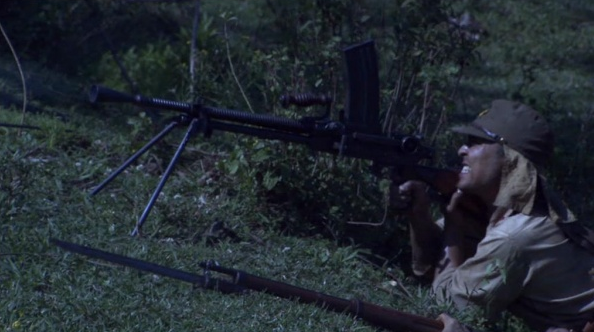
They achieved that impregnability through intelligent use of their weapons, more than by any other means, and by selecting certain guns as the key units to spot at certain points along the line. After selecting these key points and emplacing automatic weapons there, they built up other weapons around, to attain a man-tight fire plan. This last requirement demanded that each enemy must be forced to walk visibly through the fire lane of at least one weapon (usually three or more) before he could get into close quarters with any of the defenders.
So the fire lanes of the Japanese key weapons were usually sighted to crisscross at an angle of ninety degrees or more, and they were usually established along a rough line, staggered irregularly according to the terrain-lay. The less important weapons were distributed in such a manner as to support and protect the key weapons.
The key weapons in any Japanese plan of jungle defense were invariably automatics — light and heavy machine guns — and the lights always predominated.
There were always plenty of Nambu Light machine guns, one or more to every Jap squad. They were at least as thick — in the Japanese units I have seen — as Browning Auto Rifles were in our own platoons and companies. And there is not the slightest question in my mind that they killed more of us on Guadalcanal than any other weapon — perhaps more than all others put together.
Normally, when we encountered these guns in defensive positions, we would find them inside pillboxes which were logged and earthed-in overhead and thick on the sides, with only a small firing port in front. Sometimes these ports were as much as two or two and a half feet wide, permitting considerable traverse, but that was rare. Most of the time the port was little wider than it was high — no more than twelve inches at the most — in which case the gun would have no traverse at all, being able to fire only straight ahead. Always the machine gun pillbox dome was carefully camouflaged, and the front of the site was sodded or dampened to prevent giveaway muzzle blast, stirring dirt or leaves when the gun opened up.
When the fixed gun position was used, the direction of fire was always carefully sighted along or across some natural approach, with every possibility of outflanking routes and defiladed approaches well considered. Then the flanks and front were care fully spotted with covered riflemen’s pits, indistinguishable from the larger pillboxes in outward appearance. The adjacent trees and high ground points were usually manned, at least in the early phase of a fight, by riflemen spotters. To a certain extent, this made up for the greatest fault of the Japanese roofed entrenchments, their extreme blindness. This blindness was further made up for by the interlaced and mutually protecting lanes of fire, which would work effectively against enemy infiltrators.
The problems which faced our Infantry platoons assaulting such positions were vast. First the pillboxes had to be located and distinguished from dummies, which were frequently present in annoying quantity. Then they had to be approached from a route outside their fire lanes. More often than not, both of these tasks were utter impossibilities and the ground had to be gained by blind assault, which would depend upon good luck, good, fast shooting, and the intelligent application of pole charges and flame throwers.
In such an attack, or even in an attack where the boxes had been carefully located by a skilled platoon leader, there were many, many ways for a man to become a casualty. He could be picked off by a rifleman, struck by a grenade fragment, or be blasted by an electrically detonated charge planted in front of the shelter which the Japs could operate from within the pillbox. More likely than all of these, however, he could be shot with a machine gun.
Ranges in true jungle country are always short, seldom over a hundred yards, with the average being nearer twenty-five yards. In the jungle assault, the ranges are at bayonet distance in many cases, with thirty yards being the extreme if cover is of average density. You don’t even look for targets farther away than that. Should a man be shot with a rifle at such range — especially the highly humane and clean-killing ball 6.5 — he will stand a chance of living through it. Usually though, he will be shot through the body or face, for the ranges are conducive to center holds, even for the flinching and trigger-jerking Japanese. If he is hit with only a few grenade fragments, his chances will be even better. Japanese grenades were unusual performers in the manner of noise, but they didn’t seem nearly as effective away from the immediate blasts as our own. A mine explosion will usually either knock a man cold or kill him, depending on how far he is from the center of its explosion.
But with a machine gun, especially the high cyclic rate light machine guns, a man hit at such close range is a dead cookie forty-nine times out of fifty. Always sighted to shoot low, such weapons will hit a crawling man in the helmet or the body, and a standing man in the legs, in which case they usually get him in the body when he falls. The Japs normally didn’t open up until the enemy was well in the sights, probably feeling that there was little point in giving away their location for a mere leg or arm shot. Most often they got a big piece of you.
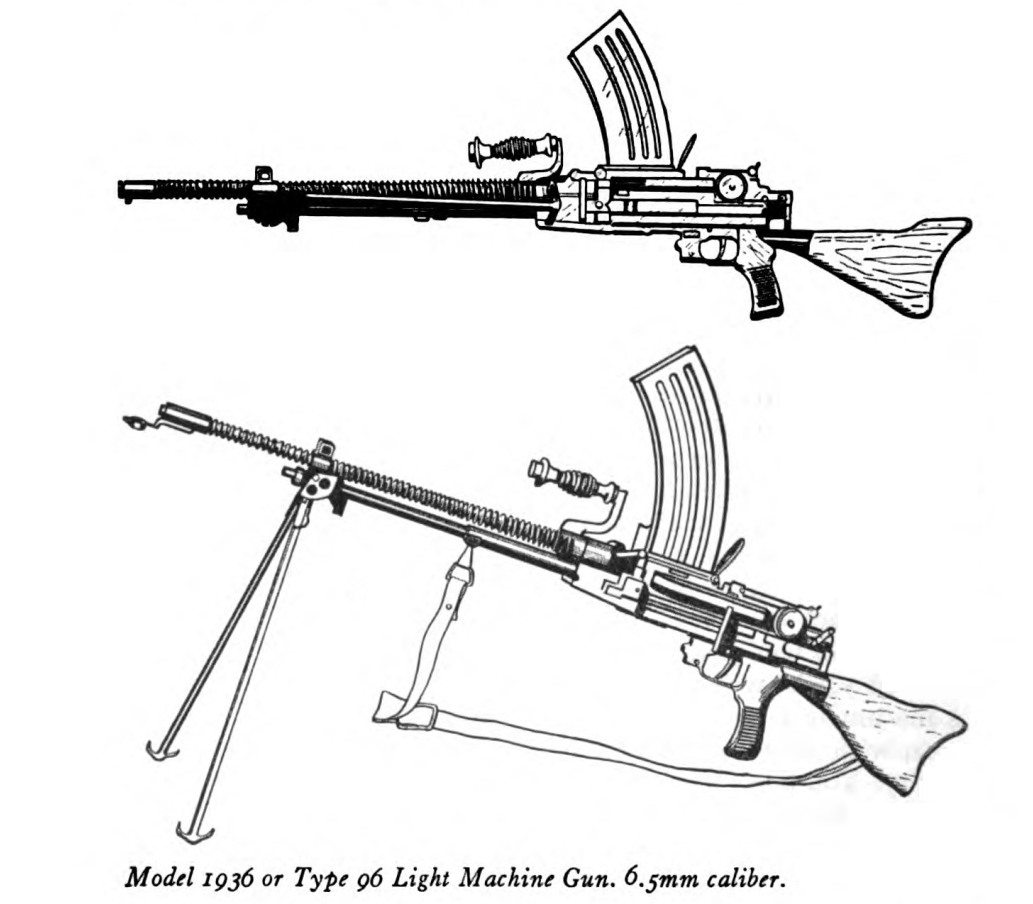
One reason a machine gun nearly always kills outright or wounds fatally is because of its rate of fire — the fact that a man is never hit with a single bullet at that range, but rather by a cluster of them, coming so rapidly that they might have as well been fired simultaneously from a multi-barrelled weapon. The average number of such hits is usually around four or five — that many going in before the stricken man writhes or falls out of the way.
That number is enough. If they strike a man in the body, they kill him. If they strike him in the bones of the arms or legs, they lacerate terribly and give fatal shock effect or else they bleed a man to death through a leg or arm artery. It doesn’t take long for a man to pump out the critical two and a half quarts through the half-inch tube of a leg artery that squirts like a half-open water faucet; and it’s quite a chore to stanch such bleeding with tools on hand while the shooting goes on. It takes a good aid man, and he has to be there!
That terrible thought often chills the mind of the soldier in the period of waiting before he goes into an attack against Japanese jungle defenses. This terror is born of the memory of horrible sights which he has seen before — visions of splintered, jagged ends of bone, with bloody flesh and marrow; of gaping wounds with intestinal juices and bits of semi-digested food gurgling out of a man who is still alive and feeling it all….
“And if it wasn’t for those Goddamn Nambu Lights, there wouldn’t be half as many….”
Those light machine guns (more properly called machine rifles) were good weapons, either the hopper fed M-11 (1922) or the clip fed, Bren-profiled M-96 (1936) job. They had many points of superiority over our equivalent weapon, which continued to be the BAR throughout the entire war. Most of these points arose from the fact that the BAR was a weapon which had been adapted to do a machine rifle job, while both of the Nambus were designed for machine rifle purposes in the first place. I have shot both weapons rather extensively, and I am sure of myself when I say that I would rather be armed with a M-1936 Nambu than with any of our BAR types. I believe it to be a better gun, though slightly less reliable in function. And if I had had an equal amount of experience with the older M-1922, hopper feed and all, I might even prefer it to the BAR as a machine rifle.
The Browning Auto Rifle, stripped of all of its machine rifle adaptations, has a role of its own in jungle warfare that is entirely different from the ordinary mission of the machine rifle. In that capacity, the Browning is a good gun, and I would not put any other brush-sprayer we have in the more vital section of a moving column on a jungle trail. Criticism here is directed against the weapon as a machine rifle, not as an assault weapon to be fired during movement. For that type of work, the Nambu would be no better.
Our own respect for the Nambus was apparently shared by the Japs, for there were firm indications that when they had had to discard weapons because of casualties or sickness, they would nearly always throw away other guns and keep their light machine guns. That procedure was often carried on to a point where every Jap along a given line would be armed with one of those damn weapons — a situation not to be desired by the opposing unit, especially if the Japs were on the defensive in the jungle and the opposing unit was ordered to root them out.
We saw both of the older 6.5mm Nambus, the M-11 (1922) (which is often not considered to be one of the true “Nambu Lights”) and the M-96 (1936), and we also saw the newer 7.7mm M-99 (1939) during the Guadalcanal show. All three models were found by our battalion and the tendency was for the weapons in a given area to be of the same type. The M-1936 was seen most often and the hopper-fed M-1922 was the most scarce of the three, as far as I was able to tell.
Of the three types, the M-1936 was most preferred by the Japanese, as evidenced by their leaving the other models behind after heavy fighting had lessened the number of operators, and hanging onto their later-designed 6.5mm weapon. This measure may have been forced by a shortage of 7.7mm ammunition, but more than likely it was an unqualified preference on the part of the troops. Anyway, we used to now and then run across discarded M-1922S and M-1939S as we moved forward through contested areas. Sometimes these weapons had been properly ruined by disassembly and scattering the parts, or by smashing the operating mechanism, but just as often, they were found whole and in perfect shape. The Japanese were always rather slipshod in the destruction of equipment left behind in the areas where I have had contact with them. In the final phase of the Guadalcanal fight, they seemed to discard all caution in that matter and nearly all of the weapons we found at Cape Esperance were in workable shape.
In that area, I had ample opportunity to give time to the study and testing of many Japanese guns. And because I rated the Nambu Lights as the most effective weapon the Japs had used against us, I lost no time in picking several of them up and looking them over. The first one I concerned myself with was the M-1936.
The M-1936 had had my sincere respect from the start. I had seen what it and the other Jap lights could do to us when we tried to move into its territory, and my first noncombatant contact with that neat little job was somewhat in the nature of the first personal meeting of two friends who had known each other for years through correspondence only. And like many such unions, this bit of personal contact served to greatly increase my respect for my old friend, confirming the good opinion I already had.
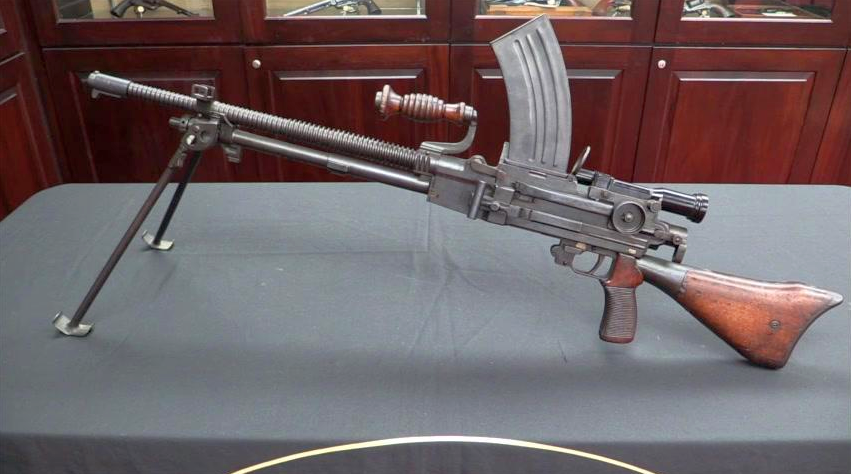
On first picking the weapon up, one is inclined to like it. It has a good “feel” — that indescribable something that our bipod-and-buttrest-fitted Browning Auto Rifle lacked completely. You could grasp the gun by its handle and run with it much better than with the BAR; it fitted to the shoulder in a much more comfortable hold than the BAR afforded; and it handled and fired better, in spite of the poorer quality of the Japanese ammunition.
The M-1936 was gas-operated, of course, and could be fired full automatic only. It was not great in length, measuring 42 inches overall on the average, with individual models varying more than an inch in extreme measurement because of variations in the length of the upper buttplate portion, which was curved back to retain the butt on the shoulder during firing.
The total weight of the weapon was 20 pounds, unloaded and with the carrying strap attached. The barrel was 21 3/4 inches long, apparently kept short on account of the long length of the receiver, which stretched out for some thirteen inches or so to house a bolt which traveled rather far for a shoulder fired weapon. A replacement barrel was nearly always carried along with the weapon (by one of the riflemen of the same squad) for alternating to prevent overheating during periods of sustained firing. This barrel, complete with front sight, gas port cup, and permanently attached carrying handle, weighed five and a half pounds.
The sights were offset an inch from the center of the barrel, and were of conventional Japanese pattern — the front one being a barleycorn type, properly enlarged and protected by a very heavy and strong set of side guards. It could be driven laterally in its dovetail in the fixed base, in the interests of making the gun shoot where it looked, and it enjoyed — on the models I have seen — one unique distinction which made it different from other Japanese front sights: It had a vertical cut in its face which had been filled with a luminous backed substance, which may have given it some value for night sighting or for shooting in the jungle.
The rear sight was a peep, securing elevation from a drum mounted on the left side of the receiver, which operated in con junction with an attached eccentric, lifting the spring loaded rear sight lever to various heights as the conveniently knurled drum was rotated counter clockwise. The inner portion of the drum was graduated in hundreds of meters from two to sixteen, inclusive, and there was a port drilled into the rear part of the housing through which the appropriate number would come into view. A poppet arrangement served to retain the setting against jarring, and it also provided a click, which could be easily heard and felt when the setting was made at any hundred meter point. There was no provision for intermediate settings, nor was there any provision for firmly locking the sight at a given setting. A good but coarsely graduated windage adjustment was provided for by a micrometer screw in the rear of the rear sight lever.
The peep itself was of practical field type, with a small rim and a fairly large aperture. A luminous dot was set into the face of the peep disc, which would presumably be used in connection with the luminous line on the front sight. How it could be used for this purpose with any effect, though, is beyond me, because it is located below the peep, which would not allow it to be lined up with the front sight — unless the firer happened to have X-ray vision to see through the metal of the rear sight assembly. Possibly these luminous markings had other uses — I haven’t been able to figure them out.
The weapon had the rough profile of the British Bren, but with marked differences in appearance showing up at a second glance. Notable among these would be the prominent spiral cut on the barrel which replaced the conventional cooling flanges, and also the appearance of the buttstock and grip, which possessed marked differences in contour from the Bren. The handle, of course, was the greatest point of similarity.
This Bren type carrying handle, which in the case of the Nambu is placed a little too far forward of the loaded balance-point, is a great convenience on any military weapon of excessive weight, providing an easy grasping point which is not too large in circumference for even a small hand. If I carried an Mi rifle all of the time I would be strongly influenced to try some such sort of a handle on it, because like most weapons of the semi-auto and automatic type, it is entirely too thick at the balance for easy grip — even if the user has a large hand. The advantages of such a handle show up when a weapon is used in combat. Our BARs certainly should have had one attached on the side. The twelve o’clock position of the handle on the Bren gun or Nambu is excusable from the visual standpoint, because the weapon already has a large half-moon magazine blocking off the view up there and another obstruction in the line doesn’t matter. The offset sights, of course, are a necessary outgrowth of this magazine arrangement.
The position of the thirty-round, half-moon magazine on the M-1936 Nambu brings up a debatable point of firearms design, and reveals (to the doughboy who has had to use the damn things) a great fault of the Bren and Nambu alike.
This position of magazine atop the receiver is highly undesirable, first, because it dangerously obstructs the view, and second, because it still more dangerously sticks up out of the grass or cover like a flag, wiggling when the weapon is fired to betray the position of the firer to any observer who happens to be to the right or left front or flanks of the gunner.
The position of any staggered-round magazine on an automatic shoulder weapon is a matter which calls for careful consideration.
The six o’clock position is out, of course, if the magazine is to hold thirty rounds. And a magazine should hold thirty rounds, the twenty we use in the BAR is not enough. To my mind, one of the chief points of the Johnson Machine Rifle which helps to make it look so much better than any of the weapons I have seen or fired, is its horizontal magazine position. It would have a few disadvantages, would probably impede movement through brush and cover somewhat, but it would get away from the primary fault of the topside jobs, which are almost suicide to use in low grass or on bare ground. Throughout the war, we generally needed to see a Jap in order to kill him with the rifle and know that we got him. Not so with the Nambu gunners — all we had to do there was to use the prominent reference point, shoot, and watch it fall down as the Jap’s shoulder gave way behind it. This fault existed, of course, with the Bren guns too, and the Britishers whom I later came to know in the Fourteenth Army were well aware of that fact. Most of them repainted their clips in appropriate colors each time they were fighting in different cover, and some of them even devised little camouflage nettings to break the clean cut outline of the tops. The Japanese I saw were not that smart.
In their infinite present wisdom, two residents of the Nipponese section of Valhalla should now be aware that I removed both of them from this world with great ease, by aiming low and to the clearly indicated rear of prominent, upsticking magazines which danced in a very eye-catching manner as they fired each burst. And I have heard of so many similar instances that I would not attempt to calculate the total number of Japanese killed by that same method.
The M-1936 buttstock utilizes only a small piece of wood, heavily reinforced in front by a sort of sleeve piece and in rear by a cupped buttplate, with screws at twelve and six o’clock. A heavy but narrow looped swivel is attached to the right side of the butt- stock, about two inches forward from the rear, by means of a sturdy through-bolt. The separate grip is a solid piece of wood, held in place by a screw and sleeve arrangement going up through its center.
On top of the receiver, when the clip is removed, the large and convenient thumb-piece which is used to release the clips for removal sticks upright for about two inches. It is located just to the rear of the magazine port, which is covered when the clips are detached for long periods of time by a thin metal door, closing by means of a hinge on the right side. The hinge is sprung to hold fast in either of two positions: — fully open or fully closed. This feature allows the weapon to be loaded quickly with one free hand. The edges of the clip port are funneled from front and rear only, but that fault is somewhat overcome by the clip release thumb- piece, which serves as a guide against the rear surface of the clip. There is also a projection on the trap door cover which sticks out from its under side and helps to guide the clip into place.
Quick and easy clip loading is a feature which cannot be stressed too much in the design of shoulder-fired automatic weapons, and it becomes increasingly paramount as the magazine capacity of a given weapon is decreased. Our BAR can be loaded with greater ease than a Nambu or Bren, and with fewer give away movements on the part of the firer, but that damn gun, with its twenty round magazines, has to be loaded more often than a weapon with the more sensible capacity of thirty rounds. Fifty would even be better!
To operate the Nambu is simplicity itself. The weapon is primarily built for firing from the prone position, and the bipod legs are made to give the gun the height which the Japanese seem to think is necessary for that type of firing — this is a little more than Americans generally think necessary. These legs lift 15 inches above any hard, flat surface. The legs are not adjustable for length, and they have only two positions at which they may be locked for use (plus one for stowage, of course). The forward of these rests the bore a slight distance closer to the ground, due to the legs pointing down at something more than the ninety degrees of the rearward position. Both positions are rather high, but in the field the high prone position has more universal use than the good old Camp Perry corn-borer position, beloved by many small bore shooters. (This latter position always seemed to have twin objectives of effecting a firm junction with good old Mother Earth and simultaneously driving the range officer nuts.) But for all its fine points on the range, the extremely low prone position has only limited application in the field. Although the combat rifleman or machine gunner has a far, far stronger incentive than the target shooter to keep very, very low, he usually has to raise his weapon and his head in order to see over the grass, stones, weeds or uneven ground, and to aim at his enemy; so the greater bipod length is not necessarily excessive.
Each of the legs is held in place by a latch near the top, and can be quickly and easily released and swung out into functional position. A clip is inserted from the top and pressed down into the port until it clicks into place. The port trap door must, of course, be opened prior to this operation. The loaded clip can be pressed home with much greater ease if the bolt is pulled to the rear before insertion.
The bolt is withdrawn initially by means of the operating handle on the left side of the receiver. The handle is hook-coupled to the bolt so that it does not fly back and forth during operation, thereby beating hell out of any part of the firer (most likely his left hand) which might get in its path. The handle will seem too large at first trial because the resistance of the driving (or recoil) spring is easy to overcome, but this size shows itself necessary when the first stoppages are encountered in using the low-standard Japanese ammunition. In such emergencies, you need a good hand hold to operate the weapon. This feature would also be valuable for cold weather firing when hands are likely to be numb.
With a loaded magazine in place and the bolt handle withdrawn and returned forward, leaving the bolt hung up in rear position on the sear, the weapon is ready to fire. It can be put on safe by means of a safety lever located in the forward trigger guard, left side; when the lever points up the gun is on safe — forward, fire. Firing is accomplished by the open breech method — the release of the sear allowing the bolt to move forward, rather than the firing pin.
In the unloading operation, the user will find that the thumb-piece is not really a thumbpiece, but rather a magazine lock, operated by the heel of the hand (either right or left) which grasps the magazine to yank it out. This is a good combat feature because if the firer makes a wild grab for the magazine, even without thinking of the latch, his hand will still release the magazine as it grabs.
The gas piston plug located under and in front of the front sight base portion of the barrel has five opening positions to which it can be turned. Numerals are stamped into the metal for reference, though there is no set rule for adjustment other than selecting the setting which makes for ideal functioning; providing enough force to operate the weapon, but without too much margin to cause excessive shock and damage to parts.
I have almost forgotten to mention that the weapon had as standard equipment a telescopic sight of two and a half power, with a field of view of some ten degrees, roughly the same optically as the one on the sniper M38 rifle. This scope was seldom used against us on the Island, and it was a part of the weapon which was easy to throw away. For that reason, we did not get a chance to test one properly. For a gun which is capable of the close grouping of the Nambu Light, though, a scope would be a definite advantage for long range spot-target shooting. For jungle use on a machine rifle, I would be strongly inclined to set aside my almost universal preference for telescopic sights and do just as the Japs did — leave the scope in the case, and plug away with the lighter and less vulnerable iron sights.
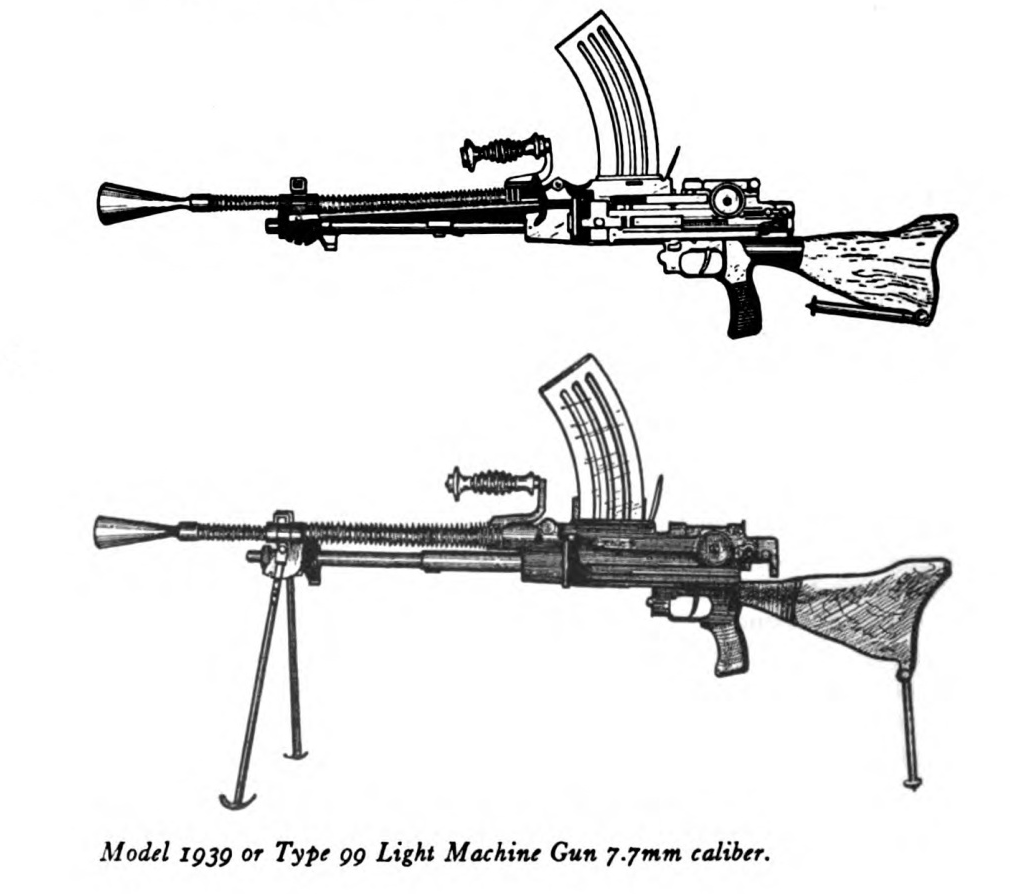
The M-1936 Nambu Light Machine Gun was plenty good, either with or without the scope, and as I have already said, it may well have killed more of us than all of the other Jap guns put together. It was easy to shoot, easy to carry for a weapon of its great firepower, and it was hellish hard on the people being shot at. Possibly the greatest tribute which can be paid to it is that the weight-hating American Infantryman who got to know the Nambu would sometimes carry it for long distances in order to get to shoot Japanese with the very few rounds of ammunition which he usually captured with it.
A secondary tribute I can give; “secondary” because it has never been any great accomplishment for an enemy to frighten me — most any healthy or sick Jap could do that:
It is that my knowledge of the capabilities of the Nambu Light Machine Guns caused me the greatest and most demoralizing fear I have known in all the combat I have seen. It was one thing to be shot; it was another to be shot with a Nambu Light. In the first case, you had a chance of unmaimed survival, but in the second, you had practically none.
The Original Nambu (Type 11 Light Machine Gun) [1]
Before the Japs designed their M-1936 light machine gun, they had already equipped themselves with a good lightweight automatic weapon to be used in their rifle squads. With the economy characteristic of the Japanese Army, this weapon was kept and used throughout the war by various units, and it was found in quantities until the very end — at least, in certain zones.
The M-1922 [sic] was a true Nambu Light, almost indistinguishable from its more recently designed kin as far as performance in the jungle was concerned. When it was being fired at you, it sounded much the same as the M-1936, and it could group its shorter bursts and hit with nearly the same effect.
In appearance, it was only roughly similar to the newer gun, and the same was true of its handling and feel. It lacked the comfortable hold and natural pointing qualities which the other 6.5mm automatic had, and in operation it was not as positive or reliable.
One of its outstanding faults was that it made necessary the use of reduced charge ammunition, with ballistics slightly inferior to those of the regular cartridge. This complicated the overall supply problem somewhat, for it added another cartridge to the list of troubles already harassing Japanese supply officers. It also brought forth the inevitable danger of getting the standard cartridge into the weaker guns during combat mix-ups.
Within units which had only the M-1922 for a light machine gun, this problem was not so great. It was standard procedure, in such cases, for Japanese units to issue the reduced charge ammunition to everyone — riflemen and all. And the recoil-sensitive Japanese soldier came to prefer the more gentle cartridge, often going out of his way to get it for use in his rifle and carbine. It made less noise than the standard round (range did not matter in the jungle) and the ordinary Japanese soldier could not have been expected to properly evaluate the advantages of penetration — which was all that could be gained by using regular ammunition in the jungle. At odd times in jungle areas, I have wished for a reduced load myself — though I would have preferred one reduced much more than was the Japanese 6.5mm.
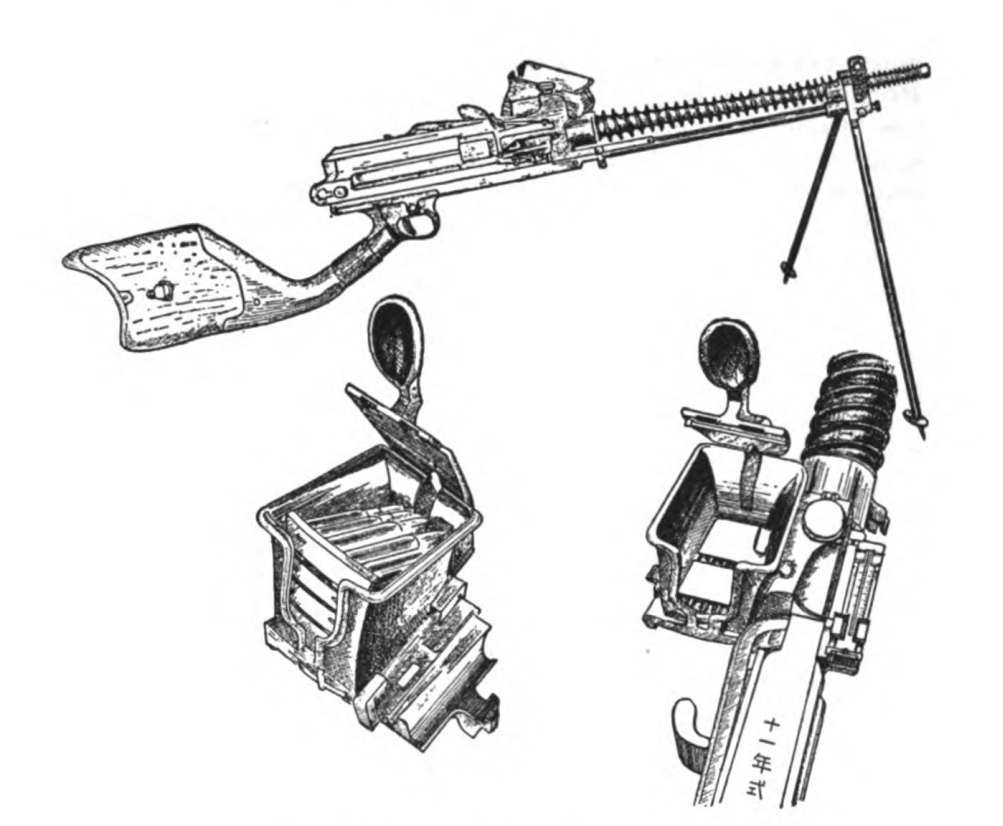
Units using the M-1922 to the exclusion of other light machine guns did not have to worry about special clips, either. The older gun was hopper-fed and didn’t need any. To load, the firer had simply to raise the large, rearward projecting trap door handle of the hopper and place six five-round rifle-loading chargers into the space provided. Knocking back the trap door would bring it down into powerfully sprung action against the top charger (“clip”) of five rounds, forcing them all downward so that the bottom clip could be tracked into the receiver by the feed assembly on the hopper’s bottom. Loading was not as fast as could be on account of the six separate packages needed for a single firing, but the weapon made up for it somewhat by dispensing with the high- projecting, giveaway clip of the later M-1936 — an advantage which served the combined purposes of supply and security.
The hopper, however, gave an ungainly bulk to the weapon at its balance point, denying it completely the quality of feel, which was later incorporated so beautifully into the M-1936. Positioned as it was, it blocked the operator’s view and made necessary a very unorthodox and awkward mounting of the sights. They had to be offset to the right for more than an inch to avoid occlusion of the normal or left side line of sight. This, in turn, caused a need for a radically offset buttstock in order to permit the shooter to get his shooting right eye more than an inch to the right of the bore- line. The weapon would be well nigh impossible for a left-eyed shooter to use — even if he were left-handed.
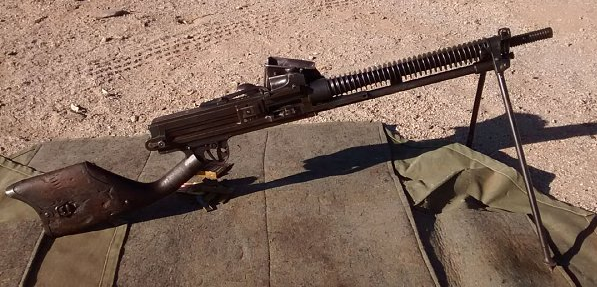
Naturally, these faults gave the weapon a strangeness of hold for anyone who had previously learned to shoot an ordinary shoulder-weapon and undoubtedly it caused a lengthening of training time. It would have been very difficult to train American soldiers to shoot the M-1922 after they had developed holding habits for orthodox weapons, and the Japanese were certainly no more versatile than we.
A debatable effect — chiefly a disadvantage — was caused by the use of the rather broad hopper. It had less height than the half-moon clip of the M-1936, but it was wider, and its top was above the shooter’s line of vision, blocking from view the entire area to the left of his immediate target. The firer was further blinded by the bulk of the oil chamber, which extended the blacked-out area of the hopper to the right for the full width of the receiver, leaving less than an inch of clear space to the left of the offset rear sight notch, or line of sight. It might be truthfully said that this fault effectually half-blinded the firer because it cut out almost fifty percent of his field of view while he remained in the firing position. Because of this, he had to raise his head frequently, deserting the line of sight with his right eye in order to check that eternal dead space on the right flank of his target. In so raising his head, he was often killed — a rather serious consequence!
The only advantage the hopper oiled arrangement gave was that it did put a vast amount of metal in front of the gunner while he sighted his weapon. This naturally held true only when he was fired at from the front, but it was effective. I know of one case where a Japanese gunner went through an entire light machine gun squad, with which he was fighting a fifty yard head-on duel, before they got him. This occurrence was, of course, no tribute to the marksmanship of the Americans, though an inspection later showed that the Jap would have been killed very early in that hair-raising, ten minute affair if he had not had that heavy, bullet deflecting hopper and oil reservoir in front of him. He had suffered several wounds in the shoulders and legs but still continued shooting until he had killed or wounded four men. The fifth soldier got him, but his gun was still in working order when picked up, though the sights were shot off of it and there were great lateral lead smears through the cooling flanges where bullets had raked along the barrel.
Each time I think of fortitude in a general way, I remember the example of that Japanese gunner who had walked up to within fifty yards of an American outpost, set up his weapon to fire in the middle of an exposed trail, and remained steadfastly there until he died. Death for him had loomed as a certainty from his very first move.
This older Nambu had sharp points on the tips of its bipod legs, with slanting hilts about an inch up. This was the same error of design which we committed in the case of our early machine rifle adaptations for the Browning Auto Rifle. The later Japanese weapon (M-1936) had flat shoes on its bipod tips, with a ridge running the length of each sole to assure against sideward movement. Our later BAR had a set of similarly shaped shoes on its bipod.
The offset buttstock of the M-1922 was styled weirdly. It had a twisted tang and grip portion which was made entirely of metal and was checkered for hand grip at the small stem. This metal part also came into contact with the cheek during firing, so on that account this must have been hell to fire in extremely cold weather.
The sights were of conventional design, with a slanting leaf rear, open notched, and elevatable in 100 meter jumps to a maxi mum of 1500 meters. The front one was a barleycorn, dovetailed into a side guarded offset base — said dovetail providing the weapon with its only lateral zeroing adjustment. There was no provision for windage. The position of the rear sight was at least eight inches forward of that of the peep on the M-1936, cutting the sighting radius of the weapon the same amount.
It lacked the highly desirable carrying handle of the M-1936 or the Bren, and had nothing to serve in its place. For that reason, there was no getting by without an asbestos mitten for the firer’s left hand, which had to be used whenever the weapon was moved during a fight. For some reason, the weapon lacked the bayonet fittings with which the later M-1936 was cursed. This omission constituted a virtue which, from the standpoint of common sense, would almost make up for the loss of the carrying handle.
Because of the weapon’s hopper mechanism, it had to be fired in five-round bursts, with a multiple pawl dragging one chargerful at a time into the receiver for firing. This was less of a fault than is first imagined because it helped to assure the conservation of ammunition — so important to the Japanese — and for jungle purposes the five-round burst is almost ideal. Five shots do the trick nicely in the jungle, and the recovery for a second five is so fast that the feature would never give the enemy time to complete even the shortest assault rush while the gunner fumbled.
The methods of stripping both the M-1922 and the M-1936, while not generally as good as those of our own weapons, were nonetheless sufficiently simple. No special tools were needed, other than a drift and a screwdriver, to disassemble the weapon for field purposes. In the matter of maintenance the employment of the M-1922 was somewhat complicated. Gunners had to always have a quantity of oil on hand to lubricate the cartridges, by keeping the reservoir atop the receiver filled. This measure, made necessary by the poor extraction method used, is the real cause of the weapon’s failure to handle the regular full charge ammunition. The side-clinging qualities of the expanded brass case were not utilized in the Nambu M-1922 to help brake the backward motion of the moving parts, but were eliminated by the use of chamber lubrication.
The large rear part of the barrel is not really barrel at all, but barrel jacket. The true barrel, which lacks the quick changing feature of other weapons, is smooth on the outside surface for three-quarters of its length, the projecting tip being the only part cut for cooling effect. The heat of firing is chiefly dissipated through conduction and radiation by the spiral cut barrel jacket. The spiral cutting, giving the effect of cooling flanges, is the same in principle on the M-1922 as on the M-1936, but the cuts are deeper. With no quick-barrel-change feature incorporated, it is necessary that the older weapon have more radiation surface to allow cooling for sustained firing. This has caused the use of a thicker profiled barrel assembly, giving the gun a heavier appearance than the M-1936. The larger overall appearance of the weapon is caused by that adaptation.
The appearance is most affected on the M-1922 by a peculiar shape and outline of the buttstock, which appears unique when looked at from any angle. I recall that distinctive appearance with special keenness because a year later in Burma, when we were fighting in an area where there were Chinese armed with Bren guns, I was able to distinguish the exact nationality of a small group of Orientals by recognizing the weapon which one of them was carrying over his shoulder. This group had walked toward us from a direction which would have normally identified them as Chinese. So it was fortunate that I could quickly recognize the difference between those weapons — the Nambu and Bren — be cause the enemy were no more than a stone’s throw away when they first came into view. After I had settled the matter of the nationality of the approaching group, we promptly dealt with them, and in a rather thorough fashion, for about ten men were kneeling near me with rifles leveled, ready to let fly when I gave the word.
After we killed them, I ordered that their weapons be destroyed. Our fight then was behind the Japanese lines in the Hukawng Valley, and we could not afford to encumber ourselves with souvenirs. I did not check carefully on the carrying out of that order, and during another ruckus the following dawn, I was violently frightened to hear the distinctive sound of a Japanese light ma chine gun firing from inside our perimeter. With many a shake and shiver, I set about the task of stalking it in the low kunai grass, with grenade and carbine.
The upshoot of it all was that I came as close to killing an American as I possibly could without actually harming him. I held my sights upon his helmet for a full minute while I pondered the possibility of a Jap wearing an un-netted helmet and shooting toward his own people from within our lines.
After an officer named Kramer had successfully disposed of the platoon of Japs who were causing the trouble, I took our man who was using the Nambu by the arm and led him down to the river where, under my personal supervision, he disassembled the weapon and threw the parts into the stream.
But don’t gather from that that I don’t have a lot of respect for General Nambu’s fine little automatic weapons. They’re all good, well within the class of our own.
____________________________
[1] The author refers to the Type 11 (named after the 11th year of Emperor Hirohito’s reign) as the “M-11” and “M-1922.” The 11th year of Showa is 1922 AD by the Western reckoning.

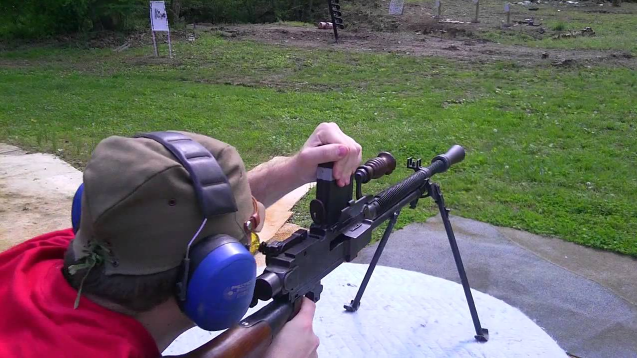

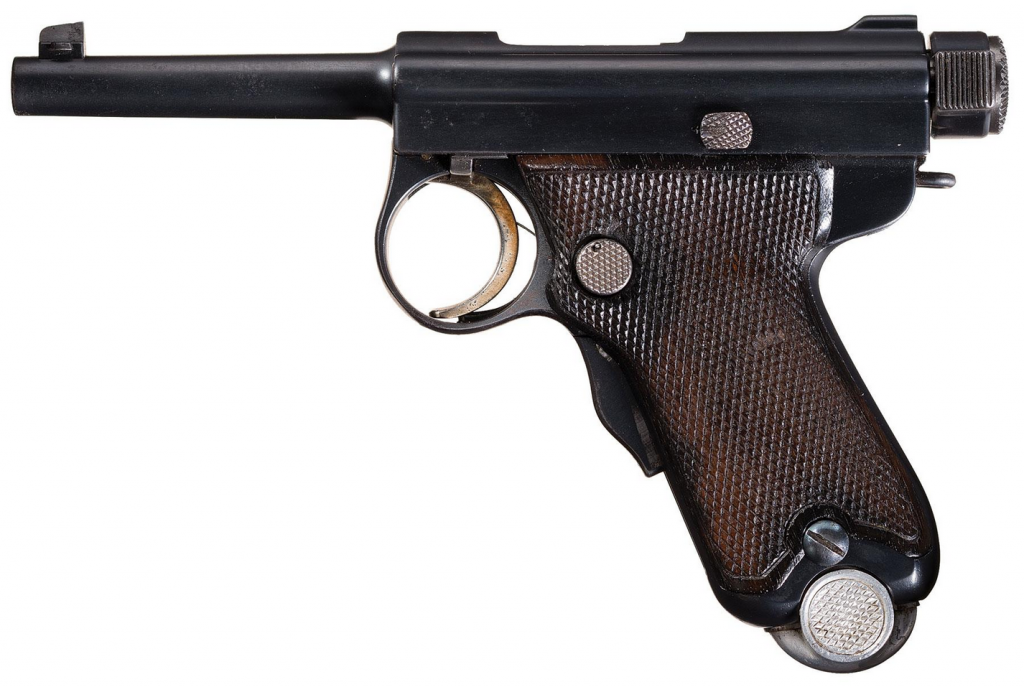


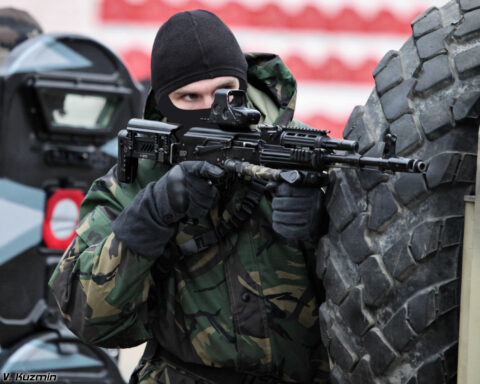
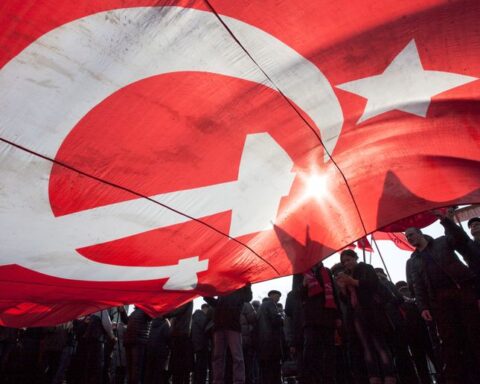
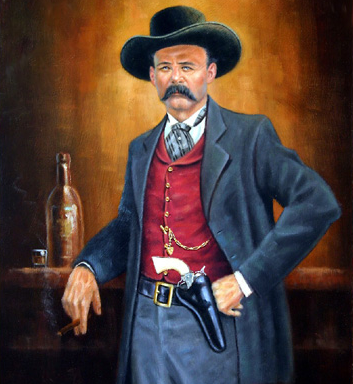
[…] (Go back to previous chapter) (Continue to next chapter) […]